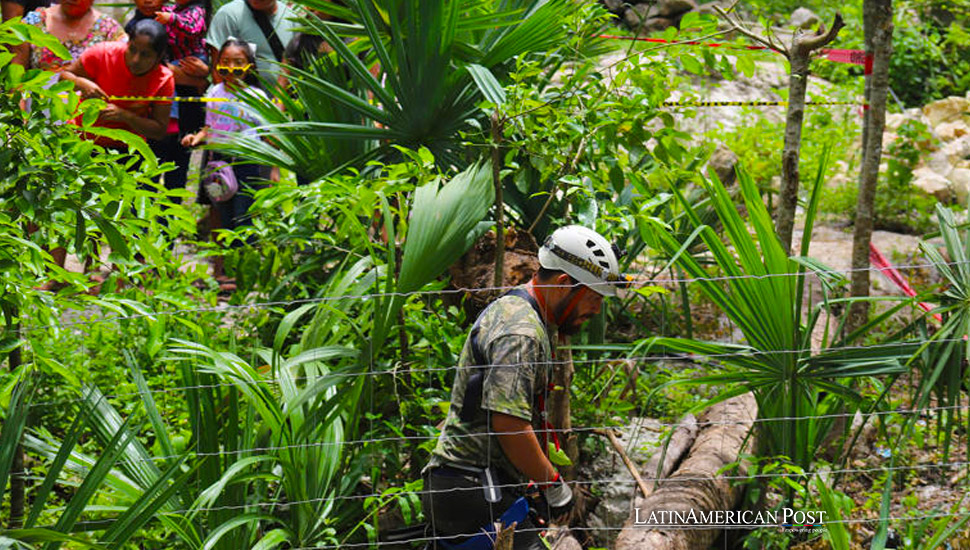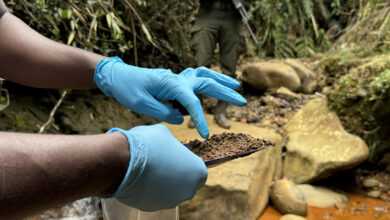Mexico’s Sacred Ceiba of Xocén Falls into the Abyss

In the heart of the Mayan world, a 30-meter ceiba tree recently fell into a cenote in Xocén, Yucatán, drawing attention from indigenous priests and Mexican officials. This event echoes deep cultural beliefs and historical significance in Latin America.
A mysterious event has unsettled the community in the tranquil Mayan village of Xocén, nestled in the municipality of Valladolid, Yucatán. Last week, residents heard a sound like thunder, only to discover that a 30-meter ceiba tree, sacred in Mayan tradition, had disappeared into the depths of a cenote—a natural sinkhole regarded as the “center of the world” by the Maya. The collapse of the cenote’s vault caused the ceiba, a symbol of life and the universe in Mayan cosmology, to vanish into the underground waters below.
Luis Emanuel Ku Ku, a resident, described the moment when the earth seemed to groan under the weight of the falling tree. “I felt like rain was coming,” he recalled, “so my mother and I went outside. We heard the ground give way, and before we knew it, the tree had completely fallen into the cenote.” The incident narrowly avoided tragedy, as local workers had finished cleaning the area two hours earlier.
For the people of Xocén, this event is not just a natural disaster but a profound cultural shock. According to Alfredo Fernández, the mayor of Valladolid, Xocénholds a unique place in Mayan cosmology, often referred to in sacred texts as the “center of the world.” Therefore, the ceiba tree’s fall carries deep spiritual significance, drawing the attention of indigenous priests and government officials.
The Ceiba Tree as a Pillar of the Mayan Cosmos
To understand the full impact of this event, it is essential to delve into the historical and cultural significance of the ceiba tree in Latin American and mainly Mayan culture. The ceiba, known scientifically as Ceiba pentandra, has been revered by indigenous peoples across Latin America for centuries. In the Mayan worldview, the ceiba represents the Yaxché, the world tree that connects the heavens, the earth, and the underworld. Its roots are believed to reach Xibalba, the underworld, while its branches stretch into the sky, connecting the human realm to the divine.
The ceiba’s fall into the cenote in Xocén can be seen as a symbolic rupture in this cosmic order. Cenotes hold a sacred place in Mayan culture, often serving as portals to the underworld and sites for ritual offerings. The fact that the Ceiba fell into such a significant site adds layers of meaning to the event, prompting speculation and concern among the local population.
This connection between natural events and spiritual beliefs is not unique to Xocén but is a common thread throughout indigenous cultures in Latin America. The intertwining of the natural world with these communities’ spiritual and cultural life has long been a defining feature of their identities. The fall of the ceiba tree, therefore, resonates far beyond the boundaries of Xocén, touching on broader themes of environmental and cultural preservation in the region.
Investigating the Collapse
In response to this extraordinary event, a team of experts, including indigenous priests, cenote specialists, and government officials from the Yucatán’s Department of Sustainable Development, have begun an investigation. The goal is to understand the causes of the collapse and to assess the stability of the remaining structure. Divers are currently exploring the depths of the cenote, which is over 30 meters deep, though visibility is low due to the debris from the fallen ceiba.
The presence of Mayan priests alongside scientists underscores the blend of tradition and modernity in addressing such events in Latin America. While the scientific team conducts geological studies to determine the resilience of the cenote’s structure, the priests offer a spiritual perspective, performing rituals to honor the fallen tree and to seek guidance from the gods.
This collaboration between science and tradition is emblematic of a broader trend in Latin America, where indigenous knowledge is increasingly recognized as valuable in addressing contemporary issues. From environmental conservation to cultural preservation, indigenous perspectives are being integrated into modern practices, creating a holistic approach to problem-solving that respects both the past and the future.
The investigation into the cenote’s collapse is not just about preventing future incidents; it is also about preserving the cultural heritage of the Mayan people. The cenote and the ceiba tree are not merely natural features; they are integral to the identity and spirituality of the community. Ensuring their protection is a way of safeguarding the living history of the Maya, which continues to influence the region’s culture and beliefs.
Xocén Village Steeped in Tradition
Xocén, despite being part of the Valladolid municipality, operates largely according to traditional Mayan customs. The village is governed by local authorities elected by the 13 Mayan sergeants, who are the guardians of the Sanctuary of the Speaking Cross, a sacred site where photography and video recordings are strictly prohibited. This unique governance structure reflects the community’s deep connection to its cultural roots and its resistance to the encroachment of modernity.
The fall of the ceiba tree has brought the village’s traditions into the spotlight, highlighting the tension between preserving cultural heritage and adapting to contemporary challenges. Xocén’s response to the event, combining spiritual rituals with scientific investigation, exemplifies this delicate balance. The village’s adherence to traditional customs, even in the face of such a dramatic event, underscores the resilience of Mayan culture in the modern world.
The event also raises important questions about the future of indigenous communities in Latin America. As the pressures of modernization and environmental change continue to mount, how can these communities maintain their cultural identities while navigating a rapidly changing world? The story of Xocén offers a glimpse into the ways in which tradition and modernity can coexist, each enriching the other and providing a path forward that honors the past while embracing the future.
The Broader Implications for Latin America
The collapse of the cenote and the fall of the ceiba tree in Xocén are more than just a local event; they are part of a larger narrative about the relationship between nature, culture, and history in Latin America. Throughout the region, indigenous communities have long faced challenges in preserving their cultural heritage in the face of external pressures. The blending of ancient traditions with modern scientific approaches seen in Xocén is a microcosm of the broader struggles and triumphs of indigenous peoples across Latin America.
Historically, Latin America has been a region where the interplay between indigenous cultures and external influences has shaped its identity. From the colonial era to the present day, the region’s history has been marked by the resilience of its indigenous peoples, who have managed to retain their cultural identities despite centuries of external domination. The events in Xocén are a reminder of this resilience and the importance of continuing to support the preservation of indigenous cultures as an integral part of Latin America’s diverse heritage.
As Latin America continues to develop and modernize, the challenge will be to find ways to integrate indigenous knowledge and practices into contemporary life without losing the essence of these cultures. The fall of the sacred ceiba tree in Xocénserves as a poignant reminder of the need to respect and preserve the spiritual and cultural landscapes that have defined the region for centuries.
Also read: The Chelemeras Maya Women Restoring Mangroves in Mexico’s Yucatán
In the end, the story of Xocén is not just about a tree and a cenote; it is about the enduring power of culture and tradition in the face of change. It is a story that resonates across Latin America, where the past and the present are constantly in dialogue, shaping the future of the region. The ceiba tree may have fallen, but the spirit of the Maya, and of Latin America’s indigenous peoples, remains strong, rooted in the very earth that sustains them.





